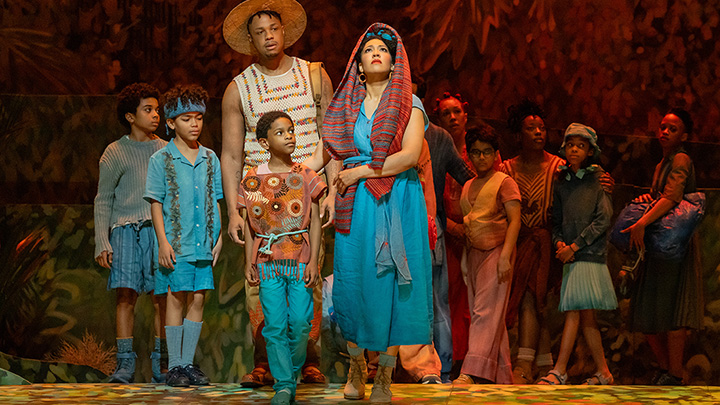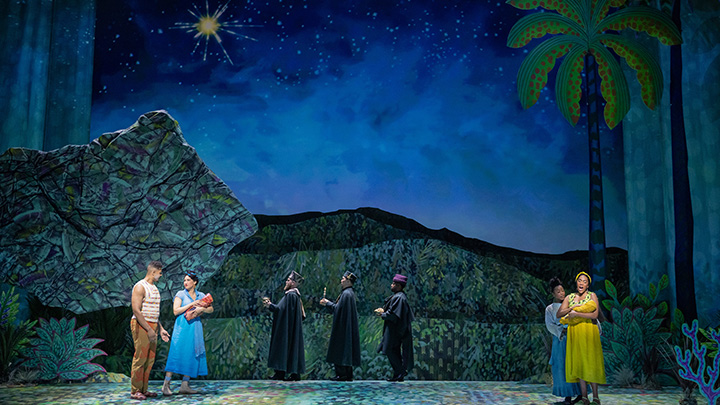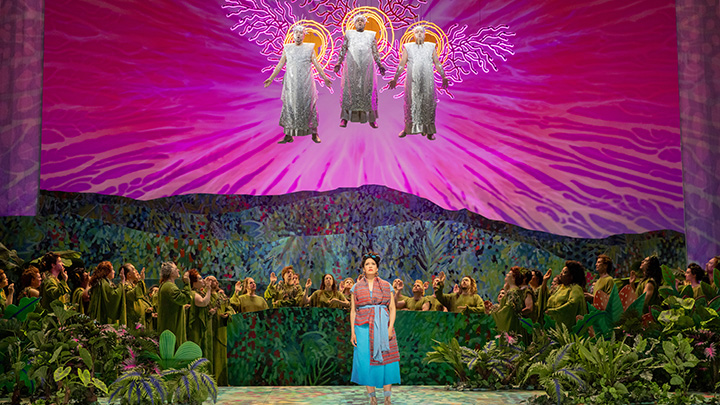
John Adams’s 2000 opera-oratorio El Niño does just that, connecting the ancient past to the equally troubled present, a mosaic of spiritual poetry from the English- and Spanish-speaking worlds over ten centuries and medieval and baroque music with 20th century minimalism.
To quote the program notes of the Metropolitan Opera’s premiere production:
Described by John Adams as his way of understanding what is meant by a miracle, El Niño is an opera-oratorio that brings the tradition of sacred works by composers like Bach and Handel into the modern era.
El Niño opened on Tuesday night in an enchanting new production by Lileana Blain-Cruz in a sensational Met debut along with several other debutants including soprano Julia Bullock, baritone Davóne Tines, conductor Marin Alsop, countertenors Key’mon W. Murrah and Siman Chung, set designer Adam Rigg and lighting designer Yi Zhao. (On May 1st and 4th, the Argentine mezzo-soprano Daniela Mack will perform as the mezzo soloist.) The audience received their efforts with genuine warmth and delight throughout the evening.
The night before the El Niño premiere, I watched the DVD of the Paris world premiere starring Dawn Upshaw, the dearly missed Lorraine Hunt-Lieberson and Sir Willard White conducted by Kent Nagano. The religious work was commissioned as a celebration of the impending new millennium. Adams and his collaborator Peter Sellars (the librettist and director) wanted to connect the conflicts of war and the travails of refugees fleeing political violence in ancient Judea to the problems of the modern world entering a new millennium.
Well ,we are now nearly a quarter century into the 21st century of the new millennium. We are facing wars in Ukraine and Gaza that are dividing our world and yielding record numbers of refugees. Mostly Hispanic refugees are being turned away or imprisoned at America’s southern border. The theme is more topical and more timely than ever. Mary and Joseph and the infant savior must also flee political violence and oppression, braving potential hostility and rejection in foreign lands – they too are refugees who are part of an oppressed minority.
I must mention that in the second act there is an apocalyptic chorus that mentions that the “towers are falling” – written over a year before the bombing of the World Trade Center. The line gave me chills (I work 100 yards from the Trade Center and went into work that September morning…)
In Paris in the year 2000, Sellars’s multimedia production was stark and contemporary with dark backgrounds, no scenery and plain modern costumes. Dawn Upshaw’s Virgin Mary wore a red plaid shirt and black skirt and the men sported button-down shirts, t-shirts, and slacks. Gritty film projections showed Mary and Joseph stand-ins fleeing in their car on the highway to Egypt. Mary and St. Elizabeth greet each other in a basement laundry room and crying policemen are comforted on urban sidewalks. Sellars created a dark world of social dystopia and ominous foreboding throughout and the musical approach followed suit. Nagano’s tempos are driving with a darker orchestral sonority and louder volume – the pounding ostinatos suggest violence ready to erupt.
At the Met, Marin Alsop in Act I keeps the textures transparent and shimmering with greater delicacy and softness evoking spiritual wonder and beatific joy at the miracle of conception and birth. The musical style is evocative of Bach and Handel played in this fashion. Lileana Blain-Cruz sets her nativity story in a dreamlike South American landscape of saturated colors and lush flowers and trees evoking the Latin American primitivist art of Frida Kahlo. The chorus is dressed in long flowing gowns in iridescent colors and fanciful headdresses. There is a sense of childlike wonder and heightened theatricality.
While the darker elements were omnipresent in the Sellars world premiere staging, Blain-Cruz successfully shifts the tone from wonder and joy in Act I to political violence and displacement in Act II with the entrance of the despot Herod. Herod (Tines) enters in military uniform evoking Mussolini, Idi Amin, Saddam Hussein and Hitler below a larger-than-life statue of himself. Soldiers with machine guns pop up in the hills and mountains upstage. A final chorus of children close the evening in a prayer lauding the new savior. They charge us with the responsibility (currently broken) that we will keep the world peaceful and whole in order that they can have a safe and positive future.
Blain-Cruz does not depend on projected film but stages many of the incidents related in the text – puppet dragons (designed by another debuting artist James Ortiz) reminiscent of Chinatown and Mardi Gras parades appeared to threaten and then fall in worship before the infant Jesus. The choreography of another debutant, Marjani Forté-Saunders, keeps the stage as full of movement as it is of color. The eye and ear are constantly intrigued and delighted with a symphony of movement, sound, and imagery full of color and life. This is actually an opera that one could take a child or non-opera person to and expect them to enjoy and to be engaged by it.
Julia Bullock has a rich, low set soprano with a plummy yet pointed resonance in the middle register (very different from Upshaw’s piping, childlike high soprano). The top can turn reedy (the voice has notable lyric mezzo colorations with similarities to Frederica von Stade) but the added warmth and sonority gave this Mary an earthy yet pure quality. Bullock has the gift of stillness and simplicity onstage, she was never affected or self-consciously arty in her delivery. The voice filled the house quite well. I must mention that Bullock (a contemporary opera specialist and advocate) has made El Niño her own personal pet project involving herself in scaled down concert versions of the work for church and chamber performances which will tour the country later this year. I look forward to her Cleopatra in the Adams Antony and Cleopatra next season.
J’Nai Bridges as the mezzo-soprano Mary/Narrator soloist started out a little tentatively with a slightly muffled delivery, but came into her own as the opera progressed, revealing a radiant, sensual presence and appealingly dusky mezzo voice (she had canceled the dress rehearsal and may be working through some indisposition). Her rendition of the Act I “La anunciación” lacked the sensual abandon and spiritual awakening of Hunt-Lieberson’s rendition, but she shined in the second half. I look forward to what Spanish speaker Daniela Mack brings to the part in May as the mezzo soloist is assigned much of the Spanish-language material.
Davóne Tines as the baritone Joseph/Herod/Narrator soloist brought another strong debut revealing a warm, velvety baritone with beautiful legato line, clear diction. A versatile artist, Tines brought a youthful sympathetic stage presence to Joseph while being properly imposing and threatening as Herod. A very promising beginning in this house for a rising young artist.
The trio of countertenors Eric Jurenas, Key’mon W. Murrah, and Siman Chung (who double as the Angel Gabriel and the Three Magi) provided a seamless blend of ethereal sound even when suspended high above the stage, flying on wires in the annunciation scene (Bullock as Mary also had her airborne moments in Act I). In his solo lines, Murrah revealed a rich distinctive sound.
Alsop maintained a virtuosic control of orchestral dynamics particularly in revealing a variety of orchestral detail while keeping the volume down to keep the voices in the forefront. Her command of the shimmering, delicately articulated orchestration in Act I was contrasted with greater density and thundering power in Act II as the Holy Family is threatened by earthly dangers. Balance, variety and abundant detail were evident all night long.
The Metropolitan Opera chorus was augmented by dancers, a children’s chorus and puppeteers bringing a sense of vibrant community which then was fragmented and driven into the wilderness in Act II. This was also a triumphant career finale for departing chorus master Donald Palumbo who was greeted with cheers by a standing audience at the final curtain calls.
The final cheers were for John Adams who strode out last and embraced conductor Marin Alsop.
This production is something of a testament to girl power since the director, conductor, the very involved lead soprano, and choreographer are all female. The change in tone, emphasis and emotional resonance in the conceptualization and realization of Adams’s opera-oratorio is a testament to their thoughtfulness.
Our divided and intransigent world is in dire need of joy, hope, peace, compassion, reconciliation, childlike innocence, and human connection. Adams’s El Niño is a radiant messenger of all of these direly needed life necessities which are being embodied on the stage of the Met in radiant color and vibrant life. It is also a fun night out. Lots of tickets are available – come together and connect with this experience.
Photos: Evan Zimmerman/MetOpera




























Comments